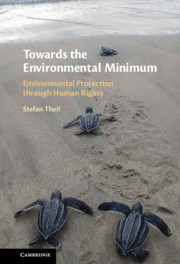Book contents
- Towards the Environmental Minimum
- Towards the Environmental Minimum
- Copyright page
- Dedication
- Contents
- Figures
- Acknowledgements
- Abbreviations
- 1 Introduction
- Part I Introducing the Environmental Minimum
- Part II The Environmental Minimum under the ECHR
- Part III Beyond the European Convention
- Part IV Beyond Human Rights Law
- 10 Environmental Regulation
- 11 International Environmental Law
- 12 Conclusion and Outlook
- Appendix: Data Methodology
- Bibliography
- Index
10 - Environmental Regulation
from Part IV - Beyond Human Rights Law
Published online by Cambridge University Press: 27 August 2021
- Towards the Environmental Minimum
- Towards the Environmental Minimum
- Copyright page
- Dedication
- Contents
- Figures
- Acknowledgements
- Abbreviations
- 1 Introduction
- Part I Introducing the Environmental Minimum
- Part II The Environmental Minimum under the ECHR
- Part III Beyond the European Convention
- Part IV Beyond Human Rights Law
- 10 Environmental Regulation
- 11 International Environmental Law
- 12 Conclusion and Outlook
- Appendix: Data Methodology
- Bibliography
- Index
Summary
The chapter focuses on domestic and international efforts to regulate environmental harm and suggests that three pathologies have historically hampered their success: political lag, which describes the gap between the best available scientific evidence and regulatory efforts to address environmental harm; Industry resistance, which arises from the fruitful ground of political lag, permitting vested interests to entrench harmful, but profitable business models and practices; and finally, regulatory inertia, which means that regulators are less likely to burden vested economic interests with effective regulations or enforce them consistently. Historic atmospheric ozone and asbestos regulation provide contrasting examples of regulatory success, and the pervasive contemporary failures in addressing air pollution demonstrates that the pathologies remain salient concerns. The chapter demonstrates that conventional regulatory approaches can be an effective tool to address environmental harm, provided that there is a close relationship between scientific evidence and regulatory action, and explores the improvements the environmental minimum can achieve.
Keywords
- Type
- Chapter
- Information
- Towards the Environmental MinimumEnvironmental Protection through Human Rights, pp. 247 - 262Publisher: Cambridge University PressPrint publication year: 2021

